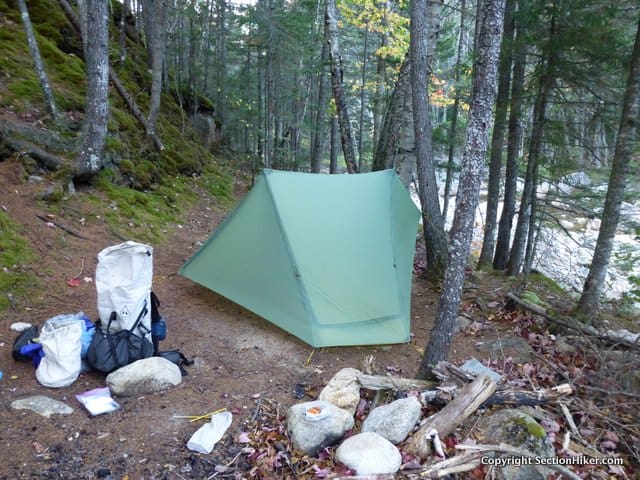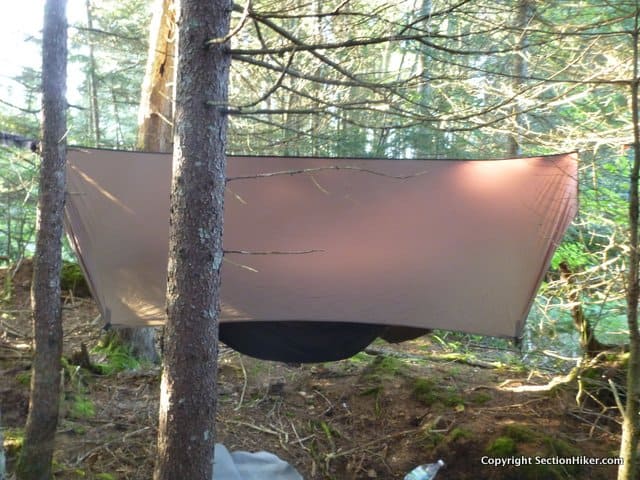
A lot of backpackers get really stressed out when planning trips because they can’t find any information about pre-existing campsites along their route. While campgrounds, lean-tos, and signed designated campsites are usually easy to find out about, that’s often not the case with the dispersed campsites you find in the backcountry that aren’t officially sanctioned, managed or maintained.
Dispersed campsites fall into two categories:
- Dispersed pre-existing campsites that people have created and used before.
- Dispersed pristine campsites where no one has camped before.
The rest of this article explains how to find dispersed pre-existing campsites and pristine campsites. It’s a lot easier to do than you might imagine. Bringing the right kind of gear helps, but studying your map beforehand can go a long way to help you find a campsite where you’ll be comfortable.
Dispersed Pre-existing Campsites
Pre-existing campsites are sites that people have used before, but aren’t signed, officially recognized, or maintained by a land manager, such as the US Forest Service, Park Service, BLM, etc. You can usually find them near water sources, near trailheads, trail junctions, and on mountain tops. They also tend to spring up along the perimeter of scenic areas where camping is usually prohibited. .
Many of these pre-existing campsites may be “illegal” and violate local camping regulations that specify where people can camp. They might be too close to ponds, roads, trails or trail junctions. Such camping rules are put in place to help preserve the appearance of natural areas by limiting the amount of use they can receive. Too much use and they’re trampled flat.

Despite this, many land management agencies turn a blind eye to pre-existing campsites because they’re the lesser of two evils. They know that people prefer to camp at pre-existing campsites, rather than create new ones, because it takes less effort to find them, and because it feels safer when you know someone’s camped there before. So they try to concentrate overuse in pre-existing areas, rather than forcing people to disperse and create new campsites.
How to find pre-existing sites
So how can you find out about pre-existing campsites in advance if you’ve never visited an area before?
- Call the rangers that oversee the area and ask them for advice about where to look.
- Look up the local camping rules and regulations before you arrive. This can help you eliminate sensitive areas from consideration if you know that camping is prohibited in them.
- Ask for help on social media.
- Search hiking blogs and websites.
- Some hiking phone apps (Guthooks Guides) have bulletin boards where people publish campsite information.
- Study your map and identify places where campsites are likely: near water sources, at major trail junctions, trailheads, or scenic area boundaries.

How do you know you’ve found a pre-existing campsite
Most pre-existing campsites can be identified by the following features:
- A fire ring, burned rocks, or partially burned logs are a dead giveaway
- Logs moved to form benches
- Flat areas with compressed leaves or tent-sized areas of bare earth surround by vegetation
In busy areas, plan to arrive a few hours before sunset so you can search for a pre-existing campsite. You can never be sure that a campsite will be unoccupied when you arrive or that the existing tenants will make room for you.

Dispersed Pristine Campsites
Many backpackers prefer to camp at pristine campsites away from other campers in a quiet and undisturbed setting. In addition, pristine campsites are often the only kind of campsites available, especially if you backpack deep into Wilderness Areas and off the beaten track.
Low Impact Camping
The name of the game when pristine camping is to leave no trace when you camp, at least that’s my preference. No one should be able to tell you’re there when you’re camping. No one should know you were ever there after you leave and you shouldn’t tell anyone else about where they’re located.
To accomplish this, it’s best to locate a campsite that’s out-of-sight of the trail and has no evidence of prior use. Areas with little vegetation are best, so you don’t trample fragile vegetation or create a recognizable trail between your campsite and a water source, cooking, or “privy” area. Limit your camping to one night if possible and return any branches or rocks to their original spot if you moved them when setting up camp, so people won’t recognize it as a campsite in the future. It should go without saying, but don’t build a fire ring or start a fire if you can avoid it.

Gear Selection
Camping in pristine campsites can be real hit or miss. While you can study a topographic map to find areas along your route that are flat, you can never really be sure what you’ll find when you arrive. In my experience, it helps to bring a small tent or a tarp that can fit in small spaces if that’s all you can find or a hammock that can be hung from trees if you’re camping in a forest. These shelters will also have the smallest lasting impact on a campsite, because they have a smaller surface area.
How to find a pristine campsite
But how do you find a suitable pristine campsite? Planning ahead is useful but you also have to think on your feet.
- Be sure to read up on the local backcountry camping regulations before setting out to understand whether and where dispersed pristine camping is permitted.
- Observe the surrounding terrain and vegetation closely as you hike to understand what the understory conditions are like if you plan to camp on the ground.
- Give yourself plenty of time before sunset to find a good site that you’re happy with before nightfall. I can take over an hour of searching sometimes.
- Watch out for widow makers.
- Don’t camp near water or in low areas because they tend to have more insects.
- Avoid windy and exposed sites.
Wrap Up
It takes more backpacking skills to find and recognize a dispersed campsite than one that’s signed and already designated for use. No matter how much you plan in advance, there’s no way to know whether a pre-existing site will be available or whether you’ll be able to find a good pristine campsite if you set out to camp in one. If you find the uncertainty of having to find a dispersed campsite each night unsettling, there’s no shame in sticking to designated campsites when backpacking, especially in unfamiliar terrain.
 SectionHiker.com Backpacking Gear Reviews and FAQs
SectionHiker.com Backpacking Gear Reviews and FAQs
Thanks for providing more great information. In my experience being adaptive and flexible ease the stress that can come with looking for pristine remote camp sites. Plan B or C is often the norm and being prepared for plan A to fall apart is quite often part of the adventure . Ironically the alternative plan almost always seems better and or more fulfilling when the journey ends.
Exactly. You need to embrace the uncertainty and look forward to the unknown, knowing that you’ll manage.
Very good information. I prefer to sleep on the ground under my tarp, but I have a lightweight hammock in my kit in case I can’t find a decent ground camping site i can always find two trees.
What is a “window maker”? Tried googling this term with no luck.
A “widow” maker is a dead tree or a piece of dead tree that can fall on you if the wind knocks it down. It’s called a widow maker because they can kill you and have killed hikers/backpackers in the past.
Excellent article, thanks Philip. I just returned from a trip using to find free tent sites on
Forest Service land, BLM (Bureau of Land Management) areas, WMA’s (Wildlife Management Areas). It was a blast. My experience says it is imperative to find a site and set up before the sun goes down. Also, always be aware of fire restrictions. Not sure about it being a legal site or fire guidelines? Just ask the authorities. Great article Philip, thanks again.
And when you find that ideal spot, do NOT post the location online or publish it in a book or share it with a meetup groupor those 6-peak challenge marketing profiteers. Because the next time you revisit it, it will have graffiti, trash, broken glass and toilet paper and charred trees. Equally damaging are those preppers woodcraft axe and saw failed carpenters.
That’s why we can’t have nice things. The bottom 10% of humans ruin it for everyone.
Yup. Completely agree.
If you find a site that looks like someone is trying to cover it up to discourage usage, please don’t uncover it and use it. In NH’s White Mountains, the Forest Service is really ramping up their efforts to clean up illegal spots with an increased volunteer steward presence.